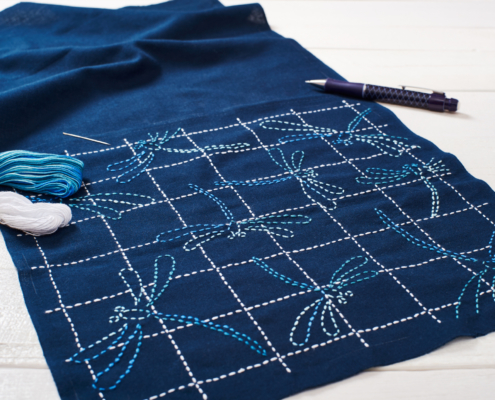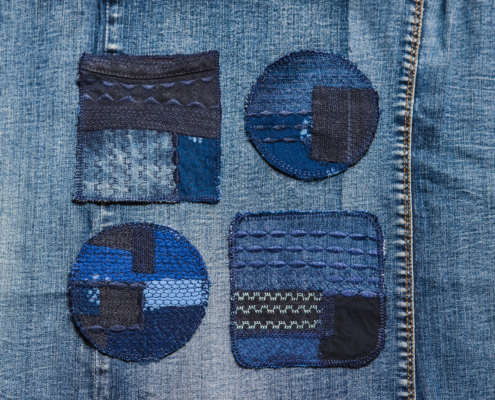01 Apr How to: The Art of Sashiko
Sashiko is more than just sewing or applying stitches to old clothes. It is the art of telling a story through mending fabrics mindfully and adding a touch of beauty to an old garment.
Initially used in pre-industrial Japan to give a second life to old clothes, Sashiko is today captivating the eyes and hearts of people worldwide. This ancient Japanese word means “little stabs” and refers to the colorful stitches that create new motives and decorations on otherwise dull fabrics.
While today there is little need for mending old clothes, the eye-catching stitches can make a garment stand out, feel more robust, and become more beautiful than it had ever been before. Never meant to be invisible, the stitches recall natural patterns, such as waves, dragonflies, or mountains. Alternatively, geometric figures like circles or interconnecting shapes can add an elegant touch to something that has worked.
While it can take a little patience and imagination, Sashiko contouring stitches can breathe new life into a cushion, jeans, throws, or jacket.

What you will need
There is not much you need to start stitching your first Sashiko design, but some of the tools are especially necessary for this technique, so you might want to add them to your sewing kit. Additionally, if you are not comfortable designing a pattern from scratch, you can follow a premade template that suits your preferences.
Sashiko Needles
Sashiko needles are indispensable for this job. They are longer than standard needles and much sturdier, perfect for running several stitches through the fabric at once. Traditional Sashiko needles are over five centimeters long, and they boast a small eye, which is ideal for controlling the thread when running it through the fabric. However, new Sashiko needles have a bigger eye and are shorter – even if still longer than standard 1mm embroidery needles.
Sashiko Threads
Sashiko threads are also particular in their build. Unlike standard embroidery floss or filaments, they are not designed to be divided into strands. Therefore, they result in much more twisted and sturdier threads, usually made of heavy-weight cotton.
While you might be able to substitute Sashiko threads with standard embroidery floss, it is essential to notice the difference in appearance between the two. Sashiko does not have a sheen, resulting in sturdier and defined stitches compared to other embroidery threads.
Thimble
While not strictly necessary, a traditional Sashiko thimble can help preserve the health of your hands and push the needle multiple times through the fabric. Alternatively, a leather thimble or a standard metal finger shield can work just as well.
Fabric
Sashiko is an ideal technique to use to bring out the beauty of linen or cotton blend fabric, traditionally in an indigo color. While you can try Sashiko mending on denim, jeans, and jacket, this technique was initially used on cotton. Indeed, since this fabric is tightly woven, the thick thread will settle better.
In terms of color, you are free to pick the combination you prefer. While traditionally, this would be a white thread on indigo fabric, any color will work, as far as there is a contrast between the tints.
Other tools
Acquiring an adequate thread, needle, and thimble is at the base of starting Sashiko mending. However, you might need other supplies such as scissors, pins, chalk, and a ruler. These materials are essential to outline your Sashiko pattern before you begin stitching.

How is it used
After you are satisfied with the design you are going to outline through the stitching, you can start your Sashiko mending. The idea behind this activity is to load multiple stitches through the needle before pulling it through the fabric and straighten up the needles.
This technique can be challenging to master at first, but it allows you to make the most out of the needle’s length while keeping the stitches in line and evenly spaced. The technique will be the same independently on the type of shape you are attempting to outline.
When practicing Sashiko, it is essential to keep in mind that different fabric can react in different ways to the threading. If stitching denim, start threading a few centimeters away from the thicker edges to ensure the material does not stretch or looks punctured.

Bottom Line
Lastly, it is crucial to remember that this ancient practice aims to add something personal to the garments, not trying to thread perfectly shaped stitches. Indeed, rather than a mistake, any imperfection is something that adds to the design. The ultimate goal of this practice to allow you to slow down, get lost in reflection, and focus on the crucial details.

